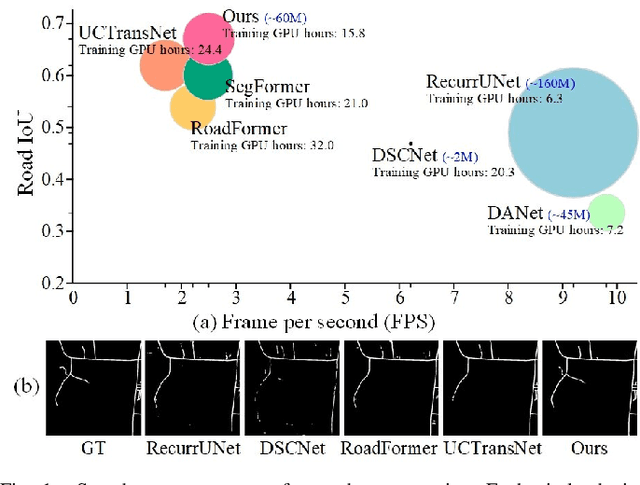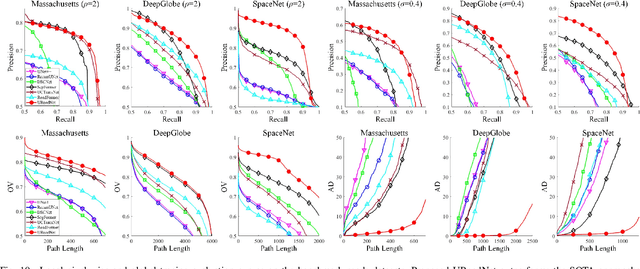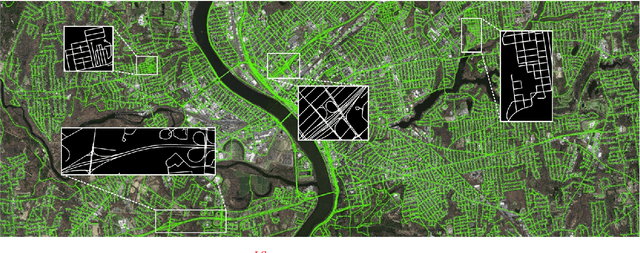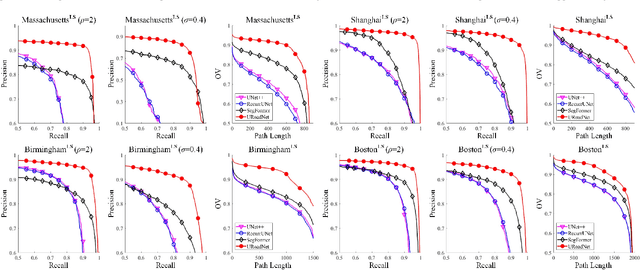Yawen Huang
Rethinking Brain Tumor Segmentation from the Frequency Domain Perspective
Jun 11, 2025Abstract:Precise segmentation of brain tumors, particularly contrast-enhancing regions visible in post-contrast MRI (areas highlighted by contrast agent injection), is crucial for accurate clinical diagnosis and treatment planning but remains challenging. However, current methods exhibit notable performance degradation in segmenting these enhancing brain tumor areas, largely due to insufficient consideration of MRI-specific tumor features such as complex textures and directional variations. To address this, we propose the Harmonized Frequency Fusion Network (HFF-Net), which rethinks brain tumor segmentation from a frequency-domain perspective. To comprehensively characterize tumor regions, we develop a Frequency Domain Decomposition (FDD) module that separates MRI images into low-frequency components, capturing smooth tumor contours and high-frequency components, highlighting detailed textures and directional edges. To further enhance sensitivity to tumor boundaries, we introduce an Adaptive Laplacian Convolution (ALC) module that adaptively emphasizes critical high-frequency details using dynamically updated convolution kernels. To effectively fuse tumor features across multiple scales, we design a Frequency Domain Cross-Attention (FDCA) integrating semantic, positional, and slice-specific information. We further validate and interpret frequency-domain improvements through visualization, theoretical reasoning, and experimental analyses. Extensive experiments on four public datasets demonstrate that HFF-Net achieves an average relative improvement of 4.48\% (ranging from 2.39\% to 7.72\%) in the mean Dice scores across the three major subregions, and an average relative improvement of 7.33% (ranging from 5.96% to 8.64%) in the segmentation of contrast-enhancing tumor regions, while maintaining favorable computational efficiency and clinical applicability. Code: https://github.com/VinyehShaw/HFF.
DGFamba: Learning Flow Factorized State Space for Visual Domain Generalization
Apr 10, 2025Abstract:Domain generalization aims to learn a representation from the source domain, which can be generalized to arbitrary unseen target domains. A fundamental challenge for visual domain generalization is the domain gap caused by the dramatic style variation whereas the image content is stable. The realm of selective state space, exemplified by VMamba, demonstrates its global receptive field in representing the content. However, the way exploiting the domain-invariant property for selective state space is rarely explored. In this paper, we propose a novel Flow Factorized State Space model, dubbed as DG-Famba, for visual domain generalization. To maintain domain consistency, we innovatively map the style-augmented and the original state embeddings by flow factorization. In this latent flow space, each state embedding from a certain style is specified by a latent probability path. By aligning these probability paths in the latent space, the state embeddings are able to represent the same content distribution regardless of the style differences. Extensive experiments conducted on various visual domain generalization settings show its state-of-the-art performance.
A Survey on Industrial Anomalies Synthesis
Feb 23, 2025Abstract:This paper comprehensively reviews anomaly synthesis methodologies. Existing surveys focus on limited techniques, missing an overall field view and understanding method interconnections. In contrast, our study offers a unified review, covering about 40 representative methods across Hand-crafted, Distribution-hypothesis-based, Generative models (GM)-based, and Vision-language models (VLM)-based synthesis. We introduce the first industrial anomaly synthesis (IAS) taxonomy. Prior works lack formal classification or use simplistic taxonomies, hampering structured comparisons and trend identification. Our taxonomy provides a fine-grained framework reflecting methodological progress and practical implications, grounding future research. Furthermore, we explore cross-modality synthesis and large-scale VLM. Previous surveys overlooked multimodal data and VLM in anomaly synthesis, limiting insights into their advantages. Our survey analyzes their integration, benefits, challenges, and prospects, offering a roadmap to boost IAS with multimodal learning. More resources are available at https://github.com/M-3LAB/awesome-anomaly-synthesis.
SP-SLAM: Neural Real-Time Dense SLAM With Scene Priors
Jan 11, 2025Abstract:Neural implicit representations have recently shown promising progress in dense Simultaneous Localization And Mapping (SLAM). However, existing works have shortcomings in terms of reconstruction quality and real-time performance, mainly due to inflexible scene representation strategy without leveraging any prior information. In this paper, we introduce SP-SLAM, a novel neural RGB-D SLAM system that performs tracking and mapping in real-time. SP-SLAM computes depth images and establishes sparse voxel-encoded scene priors near the surfaces to achieve rapid convergence of the model. Subsequently, the encoding voxels computed from single-frame depth image are fused into a global volume, which facilitates high-fidelity surface reconstruction. Simultaneously, we employ tri-planes to store scene appearance information, striking a balance between achieving high-quality geometric texture mapping and minimizing memory consumption. Furthermore, in SP-SLAM, we introduce an effective optimization strategy for mapping, allowing the system to continuously optimize the poses of all historical input frames during runtime without increasing computational overhead. We conduct extensive evaluations on five benchmark datasets (Replica, ScanNet, TUM RGB-D, Synthetic RGB-D, 7-Scenes). The results demonstrate that, compared to existing methods, we achieve superior tracking accuracy and reconstruction quality, while running at a significantly faster speed.
URoadNet: Dual Sparse Attentive U-Net for Multiscale Road Network Extraction
Dec 23, 2024



Abstract:The challenges of road network segmentation demand an algorithm capable of adapting to the sparse and irregular shapes, as well as the diverse context, which often leads traditional encoding-decoding methods and simple Transformer embeddings to failure. We introduce a computationally efficient and powerful framework for elegant road-aware segmentation. Our method, called URoadNet, effectively encodes fine-grained local road connectivity and holistic global topological semantics while decoding multiscale road network information. URoadNet offers a novel alternative to the U-Net architecture by integrating connectivity attention, which can exploit intra-road interactions across multi-level sampling features with reduced computational complexity. This local interaction serves as valuable prior information for learning global interactions between road networks and the background through another integrality attention mechanism. The two forms of sparse attention are arranged alternatively and complementarily, and trained jointly, resulting in performance improvements without significant increases in computational complexity. Extensive experiments on various datasets with different resolutions, including Massachusetts, DeepGlobe, SpaceNet, and Large-Scale remote sensing images, demonstrate that URoadNet outperforms state-of-the-art techniques. Our approach represents a significant advancement in the field of road network extraction, providing a computationally feasible solution that achieves high-quality segmentation results.
Learning Spectral-Decomposed Tokens for Domain Generalized Semantic Segmentation
Jul 29, 2024



Abstract:The rapid development of Vision Foundation Model (VFM) brings inherent out-domain generalization for a variety of down-stream tasks. Among them, domain generalized semantic segmentation (DGSS) holds unique challenges as the cross-domain images share common pixel-wise content information but vary greatly in terms of the style. In this paper, we present a novel Spectral-dEcomposed Token (SET) learning framework to advance the frontier. Delving into further than existing fine-tuning token & frozen backbone paradigm, the proposed SET especially focuses on the way learning style-invariant features from these learnable tokens. Particularly, the frozen VFM features are first decomposed into the phase and amplitude components in the frequency space, which mainly contain the information of content and style, respectively, and then separately processed by learnable tokens for task-specific information extraction. After the decomposition, style variation primarily impacts the token-based feature enhancement within the amplitude branch. To address this issue, we further develop an attention optimization method to bridge the gap between style-affected representation and static tokens during inference. Extensive cross-domain experiments show its state-of-the-art performance.
Prototype Correlation Matching and Class-Relation Reasoning for Few-Shot Medical Image Segmentation
Jun 07, 2024Abstract:Few-shot medical image segmentation has achieved great progress in improving accuracy and efficiency of medical analysis in the biomedical imaging field. However, most existing methods cannot explore inter-class relations among base and novel medical classes to reason unseen novel classes. Moreover, the same kind of medical class has large intra-class variations brought by diverse appearances, shapes and scales, thus causing ambiguous visual characterization to degrade generalization performance of these existing methods on unseen novel classes. To address the above challenges, in this paper, we propose a \underline{\textbf{P}}rototype correlation \underline{\textbf{M}}atching and \underline{\textbf{C}}lass-relation \underline{\textbf{R}}easoning (i.e., \textbf{PMCR}) model. The proposed model can effectively mitigate false pixel correlation matches caused by large intra-class variations while reasoning inter-class relations among different medical classes. Specifically, in order to address false pixel correlation match brought by large intra-class variations, we propose a prototype correlation matching module to mine representative prototypes that can characterize diverse visual information of different appearances well. We aim to explore prototype-level rather than pixel-level correlation matching between support and query features via optimal transport algorithm to tackle false matches caused by intra-class variations. Meanwhile, in order to explore inter-class relations, we design a class-relation reasoning module to segment unseen novel medical objects via reasoning inter-class relations between base and novel classes. Such inter-class relations can be well propagated to semantic encoding of local query features to improve few-shot segmentation performance. Quantitative comparisons illustrates the large performance improvement of our model over other baseline methods.
Wearable-based behaviour interpolation for semi-supervised human activity recognition
May 24, 2024



Abstract:While traditional feature engineering for Human Activity Recognition (HAR) involves a trial-anderror process, deep learning has emerged as a preferred method for high-level representations of sensor-based human activities. However, most deep learning-based HAR requires a large amount of labelled data and extracting HAR features from unlabelled data for effective deep learning training remains challenging. We, therefore, introduce a deep semi-supervised HAR approach, MixHAR, which concurrently uses labelled and unlabelled activities. Our MixHAR employs a linear interpolation mechanism to blend labelled and unlabelled activities while addressing both inter- and intra-activity variability. A unique challenge identified is the activityintrusion problem during mixing, for which we propose a mixing calibration mechanism to mitigate it in the feature embedding space. Additionally, we rigorously explored and evaluated the five conventional/popular deep semi-supervised technologies on HAR, acting as the benchmark of deep semi-supervised HAR. Our results demonstrate that MixHAR significantly improves performance, underscoring the potential of deep semi-supervised techniques in HAR.
AnomalyXFusion: Multi-modal Anomaly Synthesis with Diffusion
May 02, 2024Abstract:Anomaly synthesis is one of the effective methods to augment abnormal samples for training. However, current anomaly synthesis methods predominantly rely on texture information as input, which limits the fidelity of synthesized abnormal samples. Because texture information is insufficient to correctly depict the pattern of anomalies, especially for logical anomalies. To surmount this obstacle, we present the AnomalyXFusion framework, designed to harness multi-modality information to enhance the quality of synthesized abnormal samples. The AnomalyXFusion framework comprises two distinct yet synergistic modules: the Multi-modal In-Fusion (MIF) module and the Dynamic Dif-Fusion (DDF) module. The MIF module refines modality alignment by aggregating and integrating various modality features into a unified embedding space, termed X-embedding, which includes image, text, and mask features. Concurrently, the DDF module facilitates controlled generation through an adaptive adjustment of X-embedding conditioned on the diffusion steps. In addition, to reveal the multi-modality representational power of AnomalyXFusion, we propose a new dataset, called MVTec Caption. More precisely, MVTec Caption extends 2.2k accurate image-mask-text annotations for the MVTec AD and LOCO datasets. Comprehensive evaluations demonstrate the effectiveness of AnomalyXFusion, especially regarding the fidelity and diversity for logical anomalies. Project page: http:github.com/hujiecpp/MVTec-Caption
Learning Long-form Video Prior via Generative Pre-Training
Apr 24, 2024



Abstract:Concepts involved in long-form videos such as people, objects, and their interactions, can be viewed as following an implicit prior. They are notably complex and continue to pose challenges to be comprehensively learned. In recent years, generative pre-training (GPT) has exhibited versatile capacities in modeling any kind of text content even visual locations. Can this manner work for learning long-form video prior? Instead of operating on pixel space, it is efficient to employ visual locations like bounding boxes and keypoints to represent key information in videos, which can be simply discretized and then tokenized for consumption by GPT. Due to the scarcity of suitable data, we create a new dataset called \textbf{Storyboard20K} from movies to serve as a representative. It includes synopses, shot-by-shot keyframes, and fine-grained annotations of film sets and characters with consistent IDs, bounding boxes, and whole body keypoints. In this way, long-form videos can be represented by a set of tokens and be learned via generative pre-training. Experimental results validate that our approach has great potential for learning long-form video prior. Code and data will be released at \url{https://github.com/showlab/Long-form-Video-Prior}.
 Add to Chrome
Add to Chrome Add to Firefox
Add to Firefox Add to Edge
Add to Edge